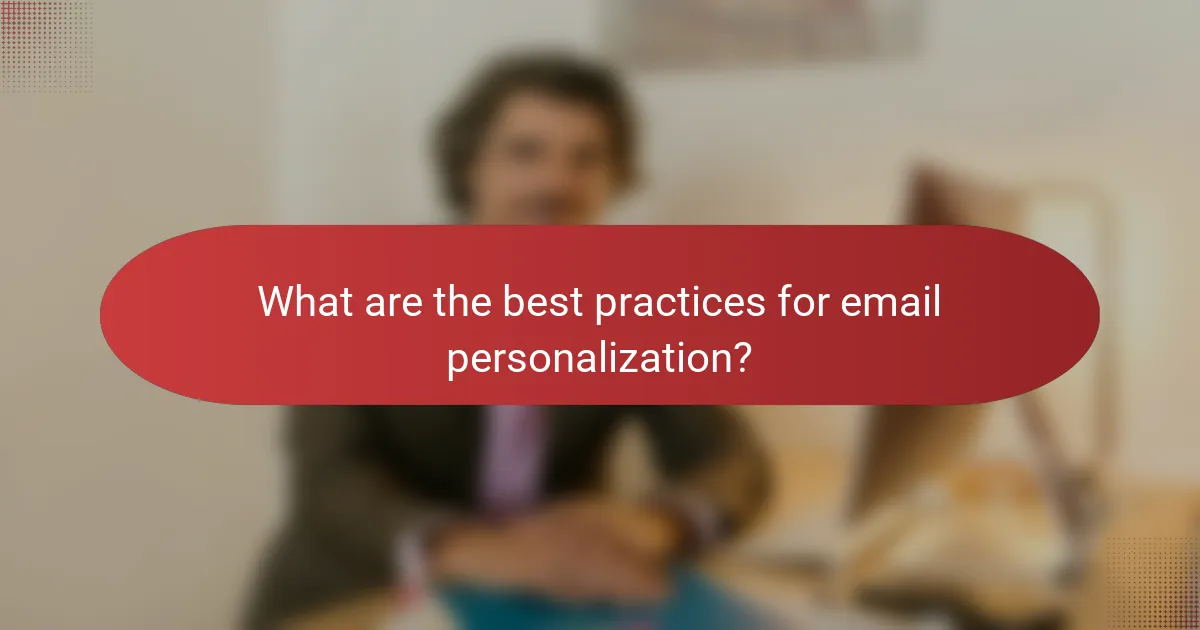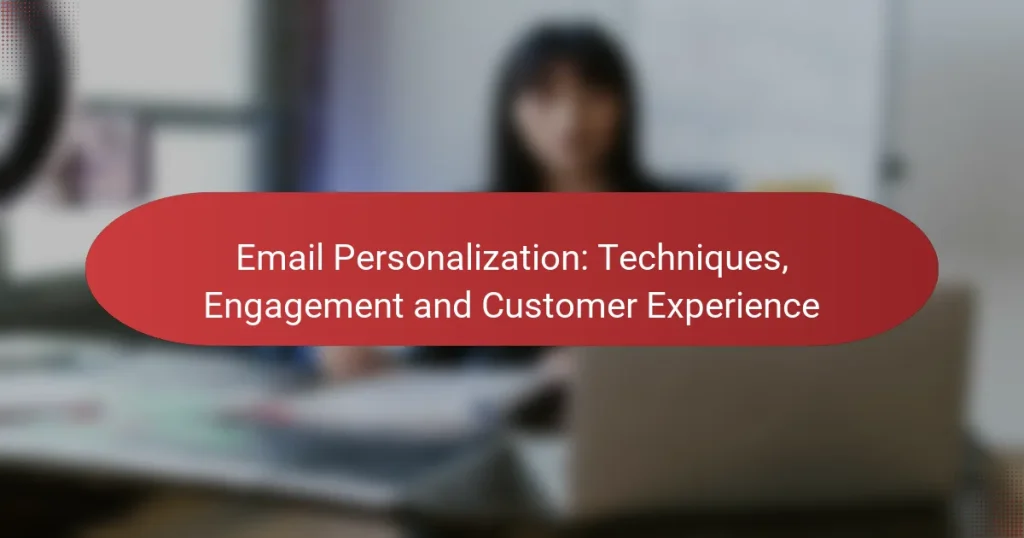Email personalization is a powerful strategy that enhances engagement by customizing content to align with individual preferences and behaviors. By employing techniques such as dynamic content, segmentation, and behavioral triggers, businesses can create more relevant communications that capture attention and foster a better customer experience.

How can email personalization improve engagement in the US?
Email personalization can significantly enhance engagement by tailoring content to individual preferences and behaviors. This approach leads to more relevant communications, which can capture attention and drive action among recipients.
Increased open rates
Personalized emails tend to have higher open rates compared to generic messages. By including the recipient’s name or referencing past interactions, businesses can create a sense of familiarity that encourages recipients to open the email.
For example, subject lines that include a customer’s first name can lead to open rates that are several percentage points higher than those without personalization. Testing different approaches can help identify what resonates best with your audience.
Higher click-through rates
Email personalization can also lead to higher click-through rates, as tailored content is more likely to align with the recipient’s interests. When emails feature product recommendations based on previous purchases or browsing behavior, customers are more inclined to click through to learn more.
In practice, segmenting your email list based on customer behavior can help deliver more relevant content, resulting in click-through rates that can be significantly improved, often by double digits.
Enhanced customer loyalty
Personalized emails foster a stronger connection between the brand and the customer, leading to enhanced loyalty. When customers feel recognized and valued through tailored communications, they are more likely to engage with the brand over time.
Implementing loyalty programs that reward personalized interactions can further strengthen this bond. For instance, sending exclusive offers or birthday discounts can make customers feel appreciated, increasing their likelihood of repeat purchases.

What techniques enhance email personalization?
Email personalization techniques focus on tailoring content to individual preferences, behaviors, and demographics to improve engagement and customer experience. Effective strategies include dynamic content, segmentation, and behavioral triggers, each contributing to a more relevant and personalized email interaction.
Dynamic content
Dynamic content refers to the ability to change email elements based on user data, such as location, past purchases, or browsing behavior. This technique allows marketers to create tailored messages that resonate with recipients, increasing the likelihood of engagement.
For example, an online retailer might display different product recommendations based on a customer’s previous purchases or browsing history. This targeted approach can lead to higher conversion rates and improved customer satisfaction.
Segmentation strategies
Segmentation strategies involve dividing your email list into smaller groups based on specific criteria, such as demographics, purchase history, or engagement levels. By targeting these segments with tailored messages, businesses can enhance relevance and effectiveness.
Common segmentation criteria include age, gender, location, and buying behavior. For instance, a travel company might send different offers to families versus solo travelers, ensuring that each group receives content that appeals to their unique interests.
Behavioral triggers
Behavioral triggers are automated emails sent in response to specific actions taken by users, such as abandoning a shopping cart or signing up for a newsletter. These timely messages can prompt recipients to take desired actions, such as completing a purchase.
For example, if a customer leaves items in their cart without checking out, a follow-up email reminding them of their abandoned cart can effectively encourage them to finalize their purchase. Implementing these triggers can significantly boost engagement and conversion rates.

What tools facilitate email personalization?
Several tools can significantly enhance email personalization, allowing businesses to tailor their messages based on customer data and behavior. These platforms offer features such as segmentation, dynamic content, and automation to improve engagement and customer experience.
Mailchimp
Mailchimp is a popular email marketing platform known for its user-friendly interface and robust personalization features. It allows users to segment their audience based on various criteria, such as purchase history or engagement level, enabling targeted campaigns that resonate with specific groups.
Additionally, Mailchimp offers dynamic content options, allowing marketers to customize email elements based on individual subscriber data. For example, you can show different product recommendations based on a customer’s previous purchases, increasing the likelihood of engagement.
HubSpot
HubSpot is an all-in-one marketing platform that excels in email personalization through its CRM integration. This integration provides valuable insights into customer behavior, enabling businesses to create highly personalized email campaigns that reflect the interests and needs of their audience.
HubSpot’s email tool includes features like smart content, which changes based on the recipient’s profile, and automated workflows that trigger emails based on user actions. This level of personalization can lead to higher open and click-through rates, enhancing overall customer experience.
ActiveCampaign
ActiveCampaign focuses on email marketing automation and personalization, making it a strong choice for businesses looking to enhance customer engagement. Its segmentation capabilities allow for precise targeting, ensuring that the right message reaches the right audience at the right time.
With features like conditional content and automated follow-up sequences, ActiveCampaign helps marketers deliver tailored messages that align with customer journeys. For instance, if a subscriber clicks on a specific product link, they can receive a follow-up email with related items, fostering a more personalized shopping experience.

How to measure the effectiveness of email personalization?
Measuring the effectiveness of email personalization involves analyzing various metrics that indicate how well your personalized emails resonate with recipients. Key metrics include open rates, conversion rates, and customer feedback, which together provide a comprehensive view of engagement and customer experience.
Open rate analysis
Open rate analysis is a fundamental metric for assessing email personalization effectiveness. It measures the percentage of recipients who open your emails compared to the total number sent. A higher open rate often indicates that your subject lines and personalization tactics are compelling enough to capture attention.
To improve open rates, consider segmenting your audience based on demographics or past behavior. Personalized subject lines that include the recipient’s name or relevant interests can significantly boost engagement. Aim for open rates in the range of 15-30% as a benchmark, depending on your industry.
Conversion tracking
Conversion tracking evaluates how many recipients take a desired action after engaging with your email, such as making a purchase or signing up for a newsletter. This metric is crucial for understanding the ROI of your email campaigns and the effectiveness of your personalization efforts.
Utilize tracking tools to monitor conversion rates and set up clear goals for each campaign. A well-personalized email can lead to conversion rates between 1-5%, but this can vary widely based on your audience and offer. Regularly analyze which personalized elements drive the most conversions to refine your strategy.
Customer feedback
Customer feedback is an essential qualitative measure of email personalization effectiveness. Gathering insights directly from recipients can reveal their perceptions of your emails and how well they meet their needs. Surveys or direct responses can provide valuable information on what aspects of personalization resonate most.
Encourage feedback by including short surveys in your emails or follow-up messages. Look for common themes in responses to identify strengths and areas for improvement. Regularly integrating customer feedback into your email strategy can enhance personalization and overall customer satisfaction.

What are the challenges of email personalization?
Email personalization faces several challenges that can hinder its effectiveness. Key issues include data privacy concerns, resource allocation, and maintaining relevance to the audience.
Data privacy concerns
Data privacy is a significant challenge in email personalization, as consumers are increasingly aware of how their information is used. Companies must navigate regulations like GDPR in Europe or CCPA in California, which impose strict rules on data collection and usage.
To address these concerns, businesses should prioritize transparency by clearly communicating how customer data will be used. Implementing robust data security measures can also help build trust and encourage customers to share their information willingly.
Resource allocation
Effective email personalization requires adequate resources, including time, technology, and skilled personnel. Many organizations struggle to allocate these resources effectively, which can lead to subpar personalization efforts.
To optimize resource allocation, companies should consider investing in automation tools that streamline the personalization process. Additionally, training staff on best practices for email marketing can enhance the overall effectiveness of campaigns.
Maintaining relevance
Maintaining relevance in email personalization is crucial for engaging customers. As preferences and behaviors change, businesses must continuously update their strategies to reflect these shifts.
Regularly analyzing customer data and feedback can help identify trends and preferences. Companies should also segment their audience to tailor content more effectively, ensuring that emails resonate with different customer groups.

What are the best practices for email personalization?
The best practices for email personalization focus on leveraging customer data, optimizing content through testing, and maintaining consistent branding. These strategies enhance engagement and improve the overall customer experience, leading to higher conversion rates.
Utilizing customer data
Effective email personalization starts with gathering and analyzing customer data. This includes demographics, purchase history, and browsing behavior, which can help tailor content to individual preferences. For example, segmenting your audience based on their interests allows you to send targeted offers that resonate with specific groups.
Consider using tools that integrate customer data from various sources, such as CRM systems and website analytics. This comprehensive view enables you to create more relevant and timely emails, increasing the likelihood of engagement.
Testing and optimization
Regular testing and optimization are crucial for refining your email personalization efforts. A/B testing different subject lines, content formats, and call-to-action placements can reveal what resonates best with your audience. Aim for a testing frequency that allows you to gather meaningful data without overwhelming your team.
Analyze metrics such as open rates, click-through rates, and conversion rates to assess the effectiveness of your personalized emails. Use these insights to make data-driven adjustments that enhance performance over time.
Consistent branding
Maintaining consistent branding across personalized emails is essential for building trust and recognition. Ensure that your emails reflect your brand’s voice, style, and visual elements, such as logos and color schemes. This consistency helps reinforce your brand identity and makes your communications more recognizable.
Additionally, consider how personalization can enhance your branding. For instance, using a customer’s name in the subject line or greeting can create a more personal connection while still aligning with your overall brand message. Avoid over-personalizing to the point where it feels intrusive or off-brand.

